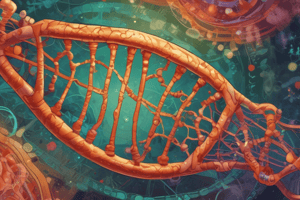Podcast
Questions and Answers
What is the primary role of mitochondria in a eukaryotic cell?
What is the primary role of mitochondria in a eukaryotic cell?
Energy production
How do mitochondria contribute to programmed cell death?
How do mitochondria contribute to programmed cell death?
Mitochondrial dysfunction plays a significant part in the initiation of programmed cell death.
Explain the importance of calcium signaling in cell communication and the role of mitochondria.
Explain the importance of calcium signaling in cell communication and the role of mitochondria.
Mitochondria help regulate calcium levels by binding calcium ions in their interior membrane, influencing cell signaling.
How do mitochondria help regulate body temperature?
How do mitochondria help regulate body temperature?
What genetic component contributes to inherited disorders related to mitochondrial function?
What genetic component contributes to inherited disorders related to mitochondrial function?
Where do over 99% of the proteins involved in mitochondrial function come from?
Where do over 99% of the proteins involved in mitochondrial function come from?
What are the three primary purposes of mitochondrial DNA (mtDNA)?
What are the three primary purposes of mitochondrial DNA (mtDNA)?
Why is mitochondrial DNA (mtDNA) more prone to mutations compared to nuclear DNA (nDNA)?
Why is mitochondrial DNA (mtDNA) more prone to mutations compared to nuclear DNA (nDNA)?
What is the initial process in energy production for ATP synthesis?
What is the initial process in energy production for ATP synthesis?
Describe the role of the citric acid cycle in cellular respiration.
Describe the role of the citric acid cycle in cellular respiration.
What is the final step in ATP production through oxidative phosphorylation?
What is the final step in ATP production through oxidative phosphorylation?
How do mutations in mitochondrial DNA (mtDNA) contribute to 'mitochondrial diseases'?
How do mutations in mitochondrial DNA (mtDNA) contribute to 'mitochondrial diseases'?
Flashcards are hidden until you start studying
Study Notes
Mitochondrial Overview
Mitochondria are membrane-bound organelles commonly found in eukaryotic cells. Initially derived from ancient bacteria via a phenomenon called endosymbiosis, they serve several critical roles beyond just generating energy:
-
Energy Production: Mitochondria are the primary producers of adenosine triphosphate (ATP), the energy currency of the cell. This occurs through a series of chemical reactions involving the citric acid cycle and the electron transport chain.
-
Apoptosis (Programmed Cell Death): Mitochondrial dysfunction plays a significant part in the initiation of programmed cell death, which helps maintain tissue health and prevent excessive cell growth.
-
Calcium Signaling: Calcium ions play a crucial role in cell communication. Mitochondria help regulate calcium levels by binding them in their interior membrane, thus influencing cell signaling.
-
Heat Generation: Mitochondria help regulate body temperature by dissipating excess thermal energy into the surroundings.
-
Inherited Disorders: Many genetic diseases affecting mitochondrial function directly result from mutations in the mitochondrial genome rather than nuclear DNA.
While the primary focus here is on mitochondrial DNA (mtDNA), it is worth noting that over 99% of the proteins involved in mitochondrial function come from the nucleus. Only 13 of the approximately 1,000 proteins necessary for proper mitochondrial function are actually encoded by mtDNA itself.
Mitochondrial DNA
Mitochondrial DNA (mtDNA) differs significantly from nuclear DNA (nDNA); it is circular, lacking histones that protect nDNA, and is more prone to mutations due to its proximity to the energetically active region of the mitochondria. Despite these differences, mtDNA serves three primary purposes:
- Encoding 13 essential proteins required for the electron transport chain's proper function.
- Regulating expression of nuclear genes involved in mitochondrial function, mainly through non-protein-coding RNA structures.
- Providing maternal ancestral information since matemals' eggs typically supply the bulk of mitochondria to early embryos.
Mutations in mtDNA can lead to a myriad of disorders collectively termed 'mitochondrial diseases.' Such conditions affect varying parts of the body based on cellular needs, making diagnosis challenging. Symptoms can manifest differently among individuals, ranging from mild to severe.
Cellular Respiration and ATP Production
Energy production in the form of ATP begins with glycolysis, where glucose is broken down into pyruvate. Pyruvate enters the mitochondrial matrix, where it is further processed in the citric acid cycle (or TCA cycle).
Oxidative phosphorylation follows, whereby electrons are passed along the electron transport chain using a series of protein complexes located in the mitochondrial inner membrane. Protons are pumped from the matrix into the intermembrane space during this process, creating an electrochemical gradient. Finally, ATP synthase utilizes this gradient to catalyze the reversible reaction of ATP from ADP and inorganic phosphate.
Studying That Suits You
Use AI to generate personalized quizzes and flashcards to suit your learning preferences.




